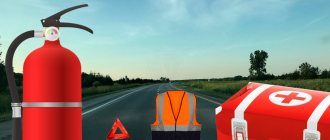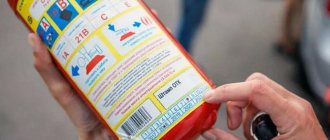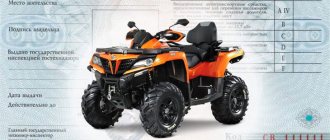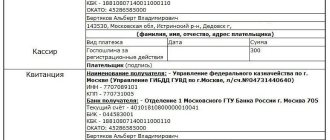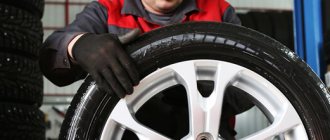In order to present a car fire extinguisher for technical inspection, you need to know the requirements in 2021 well and ensure their implementation. The occurrence of emergency situations associated with a car fire cannot be completely prevented. The driver must be prepared to act in such a situation. To do this, he must have a fully functional fire extinguisher in his car.
Should there be a fire extinguisher in the car?
Even an experienced driver cannot exclude the possibility of an accidental fire. The car always contains fuel, electrical wiring and flammable materials. If a fire occurs, a fire extinguisher will help put it out. If no measures are taken, a passenger car usually burns out completely in 15-20 minutes.
Its presence in the car is mandatory. For the absence of a fire extinguisher, a traffic police officer can fine you 500 rubles. But the inspector can find out that it is not in the car only during the inspection. It can be carried out only in cases established by law:
- If the inspector has good reason to believe that the car contains items that were used in the commission of offenses.
- There are reasons why it is assumed that explosives, narcotics or other dangerous substances are being carried in a car.
- In the event that an administrative violation has been committed.
In all other cases, the traffic police inspector cannot require the driver to present a fire extinguisher. A fine is not imposed in cases where the driver has used a fire extinguisher to put out a fire and is driving to the place where it is recharged or to buy a new one.
Place for fire extinguisher
A car fire extinguisher is a device that should always be ready and at hand. A fire extinguisher is installed both inside the car and in the trunk. The main rule is unhindered access to the device. The car is literally stuffed with flammable materials. A small flame will engulf the entire car in a matter of minutes and turn into a major fire. Easy access to fire extinguishing equipment in an emergency will help save not only valuable property, but also the lives of the driver and passengers.
Some modern cars are already equipped with a fire extinguisher from the factory; in this case, the device is installed in a special compartment. Carefully read the instructions for your car, find out where it is located and how to use such a device. Unfortunately, this is rather an exception to the rule, and most car owners will have to decide on the purchase and installation of fire extinguishing equipment themselves.
Types of fire extinguishers
A car fire extinguisher for technical inspection 2021 is usually selected from the following varieties:
- Powder copes well with flame, but at high temperatures the material can sinter with the surface. During its use, a lot of smoke is generated. When the fire is extinguished, it is necessary to remove such stains, but this is difficult to do.
- A carbon dioxide fire extinguisher can effectively extinguish a fire. It leaves no marks on the surface. Its use is associated with low temperature exposure. As a result, if used improperly, there is a danger of deformation of car parts or frostbite of people.
Air emulsion ones are more effective for small fires compared to carbon dioxide and powder ones, and do not have their disadvantages. They are compact and have a higher cost.
Water-foam fire extinguishers cannot be used when extinguishing fires in cars due to the fact that moisture will damage electrical wiring and electronic boards.
In carbon dioxide fire extinguishers, the active substance is carbon dioxide. It is a good dielectric. It takes three seconds to get into working condition.
In powder devices, extinguishing powder is sprayed under high pressure. With their help, you can quickly extinguish a fire in the temperature range from -60 to +50. Prevents the possibility of secondary fire. Will be ready for use immediately after the tap is opened.
Types of fire extinguishers for cars
Let's start with the fact that foam and water devices are not suitable for a car. The first ones have too small a volume, so they will not be able to put out a large fire. With the help of the latter, it will also not be possible to extinguish a burning fuel tank or engine.
This means that powder and carbon dioxide models remain. The second one has higher efficiency, but it also costs more. As for the first, it is necessary to identify some of its shortcomings:
- powder fire extinguishing agents do not have a cooling effect, so after their use you can expect a re-ignition;
- the powder is sprayed in the form of small dispersed particles, which reduces visibility indoors;
- over time, inside the fire extinguisher for a car, the powder collects in lumps, which often causes poor release from the nozzle of the device, and this reduces its effective action;
- powder material corrodes electrical wiring.
Powder models are marked - OP. But you can often find other additional designations. Eg:
- “B” - the cylinder is under high pressure;
- “Z” is the download option;
- "G" - with a gas-generating cartridge.
Carbon dioxide is designated as “UO”. In addition to the fact that they are highly effective in extinguishing fire, they also have their disadvantages:
- high pressure inside the cylinder means strong recoil from the device, which must be held with effort; an ignorant person can simply drop it from their hands;
- Do not hold the fire extinguisher by the outlet pipe, it gets very cold and you can injure the skin of your hands;
- Carbon dioxide in large quantities can lead to poisoning.
What kind of fire extinguisher is needed according to the new rules of 2020?
In 2021, the requirements for a fire extinguisher inspection are as follows:
- Must comply with current GOSTs: NPB 155-2002 and R 51057-2001. They determine which fire extinguisher is needed for the 2021 technical inspection.
- The fire extinguisher must be carbon dioxide or powder.
- It should have stickers with information about the device, characteristics of the active substance and instructions on how to act during a fire.
- The expiration date must be indicated on the fire extinguisher.
- For a passenger car the capacity is 2 liters, for a truck - 5 liters.
The device's suitability check must be performed annually. It must meet the fire extinguisher requirements for the 2020 inspection.
Why are plastic cases needed?
If you decide to choose a car fire extinguisher made of plastic, then think ten times. After all, all the specimens tested by experts turned out to be dummies.
Tips for choosing a fire extinguisher:
Therefore, it is not recommended to buy such a parody of fire extinguishers. It’s better to purchase a proven device than to put out a fire with an empty plastic “toy” for children.
Savvy readers may want to know about recharging fire extinguishers. However, no one currently controls the recharging points for such devices. Therefore, it is better to buy a new fire extinguisher than to spend money and after a while get zilch again. What do you think, is it worth recharging fire extinguishers or not?
We will answer your questions for FREE regarding deprivation of rights, road accidents, insurance compensation, driving into the oncoming lane, etc. Daily from 9.00 to 21.00
Moscow and Moscow region
St. Petersburg and Leningrad region
Free call within Russia 8-800-350-23-69 ext.418
Shelf life of a car fire extinguisher for technical inspection
Each type of fire extinguisher has its own period after which it is necessary to recharge:
- For powder it is 2 years.
- Carbon dioxide can be used for 5 years.
- The term for water-based is 10 years.
For each of the listed types, in most cases, the validity period of a fire extinguisher in a car for technical inspection is 10 years. For some brands of carbon dioxide fire extinguishers, it can be up to 15 years. After expiration, the expiration date cannot be extended and it is illegal to use such a fire extinguisher.
What you need to know about the requirements for automobile fire extinguishers
It is not allowed to expose the fire extinguisher to direct sunlight or precipitation, and to store fire extinguishers near heating devices. 5.3 Maintenance of fire extinguishers consists of checking the air pressure - once every three months (the indicator needle should be in the green sector), recharging the fire extinguisher - once every five years, in re-examination of the body - after five years. Recharging and repair of fire extinguishers must be carried out in specialized organizations. And finally, how to use a fire extinguisher (powder): To activate the fire extinguisher you must:
- Check the presence of working pressure in the housing using the indicator (should be in the green sector).
How is the check carried out during a technical inspection?
To pass the inspection, the driver must have:
- fire extinguisher;
- first aid kit;
- emergency sign.
The following documents are also required:
- passport or driver's license;
- vehicle registration certificate;
- if there was no registration, a passport of the technical device is required;
- If the owner's representative is being verified, then a power of attorney is required for him.
When checking the serviceability, the employee performing the inspection will definitely pay attention to the following:
- Make sure the fire extinguisher is designed for use in vehicle fires. It must be stored in such a way that it is easily accessible.
- Will check the volume and weight to make sure it is charged.
- A visual inspection will be carried out to check the condition of the housing, shut-off valves, pressure gauge and other components.
- There should be no dents, scratches or other damage on the case.
- Make sure that the expiration date has not been missed.
Inspection must occur regularly. The rules governing its passage determine the deadlines as follows:
- No technical inspection is performed during the first three years.
- In the period from three to seven years, they are checked every two years.
- Cars over seven years old must undergo inspection annually.
If the vehicle is intended to transport passengers, then inspection is required every six months.
Basis of choice
In order to choose a fire extinguisher, you need to take into account not its technical characteristics, shelf life or price, but possible risks. After all, each case is individual for a particular car, so the selection of the product must be taken extremely responsibly.
It is worth noting that a car fire extinguisher is not used to extinguish large fires, but to suppress the source of fire. This means that it can be used when the first signs of fire are noticed. Such requirements are associated with small volume and one-time use.
Fire extinguisher type
Of course, the chosen type of fire extinguishing agent for the car must meet certain standards, and this is not just a matter of passing technical inspection. It will not be able to provide adequate protection or simply will not work. Once a year, the fire extinguisher must undergo a technical inspection or test at a special stand, as it has a limited shelf life
After checking the certificate, you need to pay attention to the type of product you are purchasing. Thus, the fire extinguisher can be: powder, carbon dioxide or freon
Just remember that the latter type is prohibited for use in cars. Therefore, let’s focus on the first two: consider their advantages, disadvantages and degree of suitability for use on the road.
Volume Standards
To pass the inspection, your fire extinguisher must have the correct capacity.
In 2021, the volume standard for passenger cars is at least 1 liter, for trucks - at least 2 liters (Decision of the Customs Union Commission dated 12/09/2011 N 877 (as amended on 12/25/18).
Even if the volume matches, the inspector will check the weight of the device during maintenance. This will help determine if the fire extinguisher is 100% full. The permissible weight of the device is 1 kg for each liter of volume.
Which car fire extinguisher is used for what type of transport?
- In passenger cars and Gazelles, devices with a volume of 2 liters are used: either powder or carbon dioxide.
- In trucks - either OP or OU with a capacity of 5 liters only.
- For fuel tankers, the requirements are as follows: two 5-liter tanks.
- Small class buses are equipped with two 2 liter fire extinguishers.
- In large buses: one in the driver's compartment with a capacity of 4 liters, in the passenger compartment with a capacity of 2 liters.
If the fire extinguishing device is located outside the passenger compartment, it must be protected from sunlight and natural precipitation.
Fire extinguisher on the bus
Checking fire extinguishers
Regular inspections of fire extinguishers are carried out quarterly and annually by an employee of a convenient inspection point. In the first case, the correct location of the equipment is confirmed (the fire extinguisher must be in an easily accessible place and well secured), and the presence or absence of non-compliance with safety regulations is established.
An annual inspection involves a detailed inspection with opening and checking of filters. The inspector will check the condition of the protective coating, the seal on the safety device, the serviceability of the pressure gauge and pressure indicator (if they are provided in the design), the presence of a stamp, and the pressure inside the cylinder.
The weight of the equipment is measured, the flexible hose and sprayer are checked for contamination, corrosion and other abnormalities. At the end of the procedure, marks are placed in the device passport, and the fire extinguisher is entered into the logbook. If a fire extinguisher is found to be inoperative, it must be disposed of or recharged (when the cylinder is in good condition).
Reload
The frequency of refilling depends on the type of equipment.
The substance in the carbon dioxide model can be changed every 5 years, while in the powder model - at least once every 1.5 years.
In many situations, it is easier to buy a new device than to recharge an old one (especially for powder-type models). Purchasing a new fire extinguisher is advisable if the cylinder has begun to corrode or traces of other adverse effects have appeared. The price of refilling differs slightly from purchasing a new fire extinguisher, but the driver will be confident that the device will not fail in an emergency.
The set of measures for recharging at a fire extinguisher maintenance point includes:
- inspection;
- testing and verification of the device;
- filling the cylinder with a new substance;
- painting;
- preparation of documents confirming the completion of the procedure.
If during the inspection it turns out that the equipment cannot be recharged, it is written off.
Types of fire extinguishing devices
To understand which type is suitable for a car, we divide fire extinguishers according to the substances inside the cylinder into 4 types:
- Powder (OP). Inside the container there is a powdery mixture made from mineral salts.
- Air foam (AFP). The cylinder contains separate foaming agent and working gas, which form foam at the outlet.
- Gas (OU, VVPA). The extinguishing agent in this case is carbon dioxide or aerosol.
- Liquid or aqueous (OW). Water or other liquid is pumped into the cylinder.
What are the requirements for a fire extinguisher for a car in 2021?
The Code of Rules clearly states that fire extinguishers must be located in the cab, close to the driver, in an easily accessible place. In addition, it is necessary that the device be securely fixed in one place with special brackets (sold in stores). To put out a fire using a fire extinguisher, you must:
- Break the seal.
- Pull the pin.
- Point the nozzle at the source of the fire.
- Press the lever.
The fire extinguisher may operate with a slight delay.
How many fire extinguishers should there be?
The number of extinguishing devices for vehicle registration and maintenance is regulated by SP 9.13130.2009 (Appendix B, clauses B1 - B2) and the “Fire Safety Rules” (clause 212). The parameter depends on the weight, purpose, and capacity of the machine.
In a car
Passenger cars are equipped with at least 1 product with a charge weight of 2 kg and 2 liters. Required capabilities: extinguishes model fires from 0.7A and 21B.
In a truck
For cargo vehicles you will need:
- for vehicles up to 3.5 t - one (2 kg, 2 l, from 0.7A and 21V);
- trucks for transporting people or weighing from 3.5 to 7.5 tons, combines, tractors - two similar;
- Vehicles from 7.5 tons, transporting dangerous goods (trucks, fuel tankers, tank trucks) - two from 2A and 70B.
In the bus
For buses weighing from 3.5 - 7.5 tons, you will need 2 similar fire extinguishers with a charge weight of 2 kg, 2 liters.
Device requirements
Any car fire extinguisher has a number of mandatory standards.
These include:
- Compliance with GOST standards.
- Volume for cars weighing up to 2 tons is at least 2 liters, over 5 liters.
- Compliance with time frames. The closer to their completion, the worse the quality of the downloaded material.
- Weight control. When stopped by a traffic inspector, the parameter is checked without fail. It ranges from 2 to 5 kg, depending on the car.
- Marking. It indicates information about the organization performing maintenance of the device.
Compliance with GOSTs
The existing requirements for this group of products are very stringent. They are spelled out in a number of documents and enshrined in legislation.
The main ones include:
- NBP 170-98. General purpose fire extinguishing powders.
- GOST R 51057-2009 from 01/01/2010 – Portable models. Technical requirements. Test methods.
- GOST R 51057-2001 – Portable models. Test methods.
The requirements specified in the documents are mandatory for all road users.
Volume
Modern fire extinguishing devices are available in cylinders of different capacities. They can be:
- Up to 5 liters – small manual models.
- 5-10 l - cylinders used for industrial purposes.
- More than 10 liters - large mobile or stationary models.
Weight
Fire extinguisher weight.
The parameter implies the weight of the fire extinguisher along with the material pumped inside.
Based on it, devices are divided into:
- Portable (up to 20 kg). Can be transported without additional equipment.
- Mobile (from 20 to 400 kg). Their movement involves the use of a special trolley.
Check and recharge period
The time frame for the operation is regulated by fire safety rules. The period between their implementation is 1-5 years. But there are exceptions.
If the cylinder body is damaged, technical inspection is carried out unscheduled.
Marking
The fire extinguishing device label must contain the following information:
- Full information about the manufacturer (legal address, telephone, email, etc.).
- Labeling.
- A pictogram indicating which classes of fire can be extinguished by the cylinder.
- Certificate of conformity number.
- Production date.
Availability of information is mandatory. If it is not available, contact another seller.
Extinguishing agent type
The material pumped into cylinders has a different composition and different characteristics.
Based on the type of substance, devices are divided into the following models:
- OP. There are general and special purposes. The extinguishing agent is powder.
- OU. The material pumped inside is carbon dioxide. Effective when extinguishing flammable liquids.
- Liquid. The devices are charged with an aqueous solution containing chimeric impurities. Can only be used at positive air temperatures.
- OP (foam). The cylinder is filled with aqueous solutions of acids and alkalis, which upon contact with oxygen form a thick substance.
- ORP (air-foam). The material used is PO-1 solution. Effective in extinguishing many classes of fires.
- Aerosol. The mixture in the container is a halogenated hydrocarbon. Extinguish everything except alkalis and substances containing oxygen.
